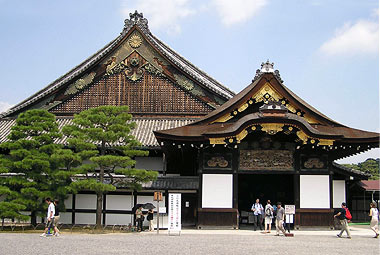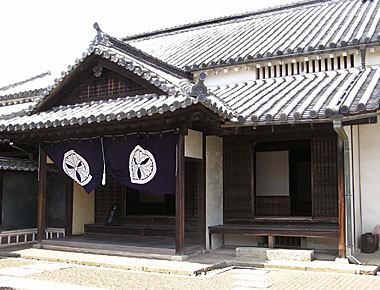|
||
 |
||
2 From the early decades of the 17c the term genkan came to be applied to a porch-like projection from the guard house or retainers room, built in the residences of leading warriors and shoguns. This functioned as an entrance porch, kurumayose 車寄せ, and was sometimes referred to as kurumayose genkan 車寄せ玄関. It had solid flanking walls, a paved floor and a flight of steps at the far end giving access to the room beyond. By the 1630's the genkan was equipped with a low broad timber step *shikidai 式台, upon which the visitor could alight from his palanquin, koshi 輿. One or two steps above the shikidai, the interface with the room beyond typically consisted of two pairs of sliding panels *mairado 舞良戸 or itado 板戸. Originally this porch-type genkan was added to the building for the use of retainers, but by the early 17c it had been transformed into a formal entrance, onari genkan 御成り玄関, which was a symbol of high social status, restricted by legislation to members of the warrior class, the aristocracy and leading religious figures.

Nijoujou
Ni-no-maru goten 二条城 二の丸御殿 (Kyoto)
3 In the latter half of the Edo period, an abbreviated version of genkan in two above. Sometimes projecting no further than the width of a veranda *engawa 縁側, but usually a complete platform *shikidai 式台 for boarding and alighting from a palanquin. Often had a decorative gable, and was generally found in middle-ranking warrior residences, serving as the formal entrance to the guest reception suite *zashiki 座敷. Apart from formal guests, its use was normally restricted to the master of the house, while other family members used another less elaborate entrance constructed nearby. In the case of vernacular houses *minka 民家, possession of a genkan was prohibited during the Edo period, but by the 18c the houses of leading merchants and village headmen shouya 庄屋, as well as feudal lords' lodgings *honjin 本陣 were increasingly permitted to build genkan as part of *shoin 書院 style guest reception suites. Genkan were also permitted on the houses of doctors, and officials in charge of important shrines, shinkan 神官. The genkan was usually added to the outermost room of the reception suite. Although the grandest minka genkan were elaborately gabled projecting porches, the majority were incorporated into the periphery of the building *hisashi 廂. In town houses *machiya 町家, an internal genkan with shikidai was often be constructed within the earth-floored area *doma 土間 to provide a formal point of entry to the raised living area kyoshitsubu 居室部.

Nagatomi
永富 house ( Hyougo)
4 From around the end of the Edo period, the main entrance to the houses of lower-ranking warriors and foot soldiers ashigaru 足軽. It often included an internal earth-floored area for removing shoes, but lacked a shikidai. This type is the forerunner of the genkan used in the average modern Japanese house.
5 An abbreviation for genkan-no-ma 玄関の間.
(C)2001 Japanese Architecture and Art Net Users System. No reproduction or republication without written permission.
掲載のテキスト・写真・イラストなど、全てのコンテンツの無断複製・転載を禁じます。

